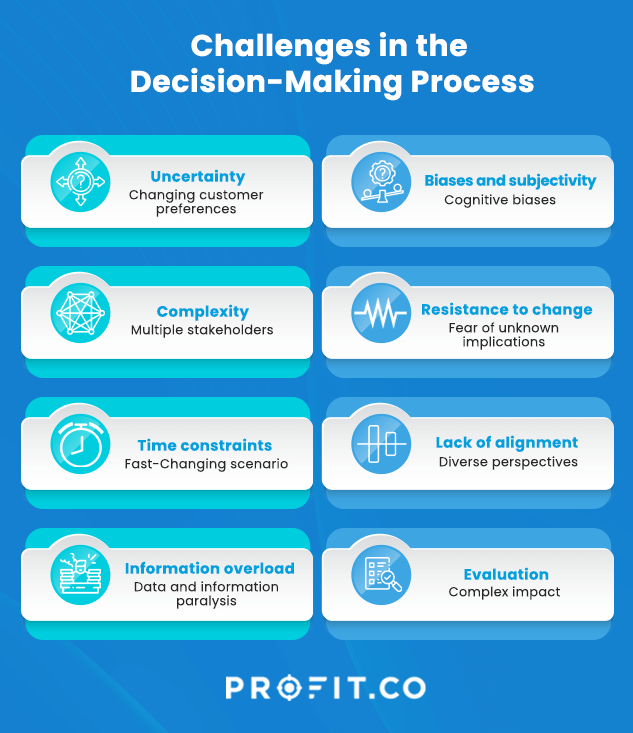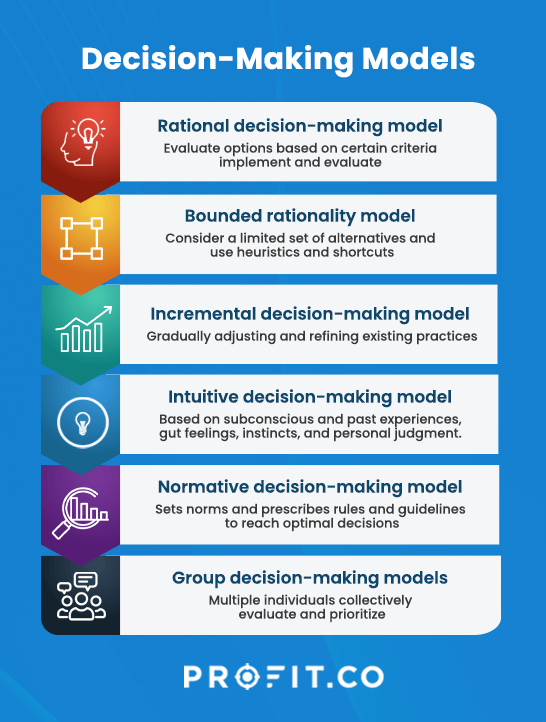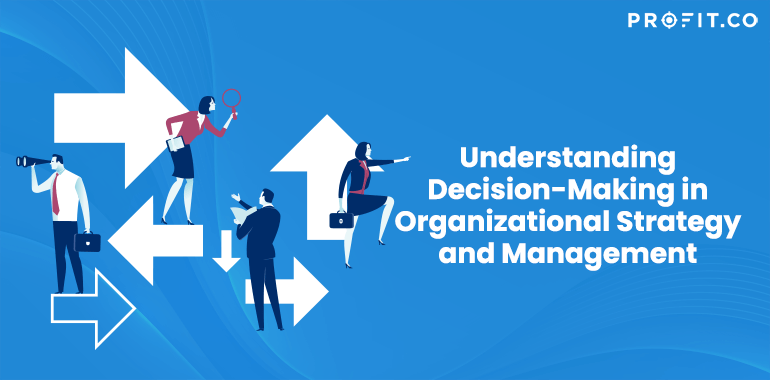Every important decision can make or break a business, and the success or failure of an organization depends on how sound your decisions are. So the importance of collecting relevant information, listing options and potential alternatives, and considering everything before making business-critical decisions must be balanced.
Decision-making is neither simple nor straightforward. You need to study the data, analyze the inferences, and understand the various aspects and implications of your decisions, including financial implications, market conditions, legal and regulatory requirements, operational feasibility, resource availability, and potential risks. You may also assess every alternative decision. A holistic view ensures that decision-makers have a complete picture and can anticipate potential challenges or unintended consequences.
In addition to this, all your decisions need to be coherent and logical, in line with your strategy and your preceding decisions. If your decisions lack continuity and consistency, they can seriously impact the organization.
whenever you see a successful business someone once made a courageous decision
For instance, if you have built a company with a premium brand image, offering high-quality, high-end products, then your decisions must reflect the strategy through excellence in all areas. Suppose you start cost-cutting in crucial operations of your business, such as customer support. In that case, it will compromise the quality and customer experience that the customers come to expect from you. Such decisions can lead to the failure of your strategy.
To make consistent decisions every time, and avoid decision fatigue you need to follow a systematic and thorough approach to decision-making to minimize risks, maximize opportunities, and achieve your strategic objectives. You need an optimized decision-making process that lets you make the right decisions every time.
Table of Contents:
- What is a decision-making process?
- How does the decision-making process impact the organizational strategy?
- What are the steps involved in the decision-making process?
- What is decision management?
- How does a structured decision-making process impact your business?
- Challenges in the decision-making process
- What are decision-making models?
- FAQs
What is a Decision-Making Process?
The decision-making process is a structured, systematic approach that enables individuals or groups to identify, evaluate, and choose the most appropriate action after thoroughly assessing various alternatives to solve a problem or seize an opportunity. The decision-making process consists of steps that guide decision-makers in collecting essential information, analyzing options, considering relevant factors, and making a sound, well-informed choice.
How Does the Decision-Making Process Impact the Organizational Strategy?
The decision-making process and organizational strategy are closely knit together, as every business-critical decision plays a crucial role in shaping the strategic direction of an organization and strategy execution. Simultaneously, the organizational strategy provides the framework and context for decision-making, ensuring alignment, adaptability, and ongoing improvement in achieving strategic objectives. Decision-making and strategy are connected in the following ways.
- Strategic alignment
The decision-making process ensures that every decision is aligned with the organizational strategy, as the process is shaped by the organization’s strategic goals, overall organizational objectives, and priorities. The organization’s strategic direction directly influences strategic decisions, such as venturing into new markets, developing new products, making investment decisions, etc.
- Resource allocation
Resource allocation or resource management is one of the key aspects of strategy that requires making highly informed choices. Listing the various projects, initiatives, business units, tasks, and operations and judiciously allocating adequate financial, human, and technological resources for each play an essential role in supporting the organizational strategy. These decisions are made based on strategic priorities and the desired outcomes.
- Risk management
Calculated risks are part of strategic decision-making while pursuing opportunities and addressing challenges. So achieving strategic objectives requires risk management. A structured decision-making process helps you identify potential risks, forecast their potential impact on the organizational strategy, find alternatives and workarounds, and determine the risk mitigation strategies. It also gives you a complete understanding of the risks and opportunities while making decisions.
- Strategy execution
Strategy execution necessitates effective operational, tactical, and strategic decision-making. A structured, systematic decision-making process ensures uniformity, coherence, and continuity in decision-making so that the strategy gets translated into sound, actionable decisions with clear goals, action plans, and performance metrics. All these decisions at various levels of the organization come together and collectively contribute to the strategy execution.
- Adaptive decision-making
As the organizational strategy is constantly adjusted and adapted to changing conditions and emerging developments in the business environment, the decision-making process plays a key role in enabling organizations to adapt to new circumstances, market trends, customer preferences, and competitive forces. Making strategic decisions in line with the organization’s changing needs helps you effectively respond to internal and external challenges.
- Learning and continuous improvement
Since the decision-making process involves evaluating the outcomes and impact of the decisions, collecting feedback, and analyzing the effectiveness of the process, it provides you with the opportunity to learn continuously and identify areas of improvement in the strategy and strategy execution.
What are the Steps Involved in the Decision-Making Process?
The decision-making process in a business environment may vary depending on the specific situation, the nature of the decision, the organizational design, and the hierarchy. Further, decision-making is often an iterative process, and the steps involved may sometimes follow a more relaxed, linear order. However, the most common sequence of the decision-making process usually involves the following steps.
1. Define your decision
Identifying a problem, understanding the nature of the problem, and identifying the decision required to solve the problem are prerequisites to deciding-making. So you have to thoroughly assess the problem or opportunity at hand and identify the need to make a decision. Once you identify the need for a decision, you must come up with clear objectives and define the scope of the decision-making process.
2. Gather relevant information
Once you identify a decision, you must look for the information on the problem or the opportunity by conducting market research, collecting data, looking into facts, and assessing them to produce insights that help you understand the situation better. When you have all the facts and actionable insights, you can get a clear picture and a comprehensive understanding of all the factors influencing the decision.
3. List the options and analyze them
Before making a decision, you need to list all the possible actions you can take and thoroughly assess each to determine the most viable option that could produce the best outcomes and achieve the desired results. Empowered with all the relevant information and insights, you can consider various factors such as cost, feasibility, risks, benefits, and potential outcomes of every alternative course of action.
4. Evaluate the alternatives
After analyzing the options, you can evaluate them and select the most suitable alternative. For that, you have to determine how each of those options aligns with your business strategy, goals, and objectives; assess the strengths and weaknesses, and pros and cons of each; forecast the potential impact of each on the organization in the short term and long term; and compare these options.
5. Make the decision
After evaluating all the options, you can select the most suitable course of action based on the data, facts, insights, and your comprehensive evaluation. The decision making should be backed by sound reasoning and robust logic. It should be based on all the relevant factors and alignment with your strategy.
6. Implement the decision
Choosing an option and making a decision based on sound reasoning is one thing, but implementing it is an entirely different aspect of decision-making. You will need an implementation plan for creating a roadmap and listing the actionable steps, judiciously allocating resources for various actions, assigning responsibilities, and executing the chosen course of action. Implementing the plan requires effective communication across the organization and coordination within the teams. Communication, coordination, and teamwork during the implementation play a crucial role in the successful implementation of the decision.
7. Review the decision
Finally, after you make the decision and implement it, you need to review and evaluate the decision and its outcomes to verify the impact. To review the decision, you must assess its effectiveness in achieving the desired results, identify any unexpected consequences or issues that may have arisen and analyze their root causes, learn from the decision-making process, and document it for future reference. By reviewing the decision, you can gain valuable insights that will help in future decision-making and constantly improve the strategy.
Ready to start your structured decision-making process?
How do OKRs help with the decision-making process?
OKRs facilitate effective decision-making by providing a structured alignment between an organization’s strategic goals and measurable key results. This alignment offers clarity and direction for decision-making processes, ensuring that each decision contributes meaningfully towards achieving organizational objectives. As a result, utilizing OKRs enhances the overall focus, precision, and success of decision-making within an organization.
What is Decision Management?
As businesses move towards digital transformation, they are exploring the automation of decision-making processes. Decision management automates the decision-making process by combining business rules and machine learning to create workflows that automate business decisions. Streamlining repetitive tasks and optimizing workflows is crucial in business process automation.
How does a structured decision-making process impact your business?
A structured decision-making process helps you:
- Minimize risk
When you have all the relevant information, a list of potential alternatives, and a clear picture of the risks and challenges associated with each option, the decision-makers are better prepared to face them during implementation. It helps them make informed choices, minimize the risks, and develop contingency plans to mitigate adverse outcomes.
- Maximize opportunities
Having numerous alternatives helps you explore all the possibilities and identify the opportunities that may otherwise be overlooked. By exploring all the possibilities, you can increase the likelihood of uncovering innovative solutions and capitalizing on emerging trends or market gaps.
- Enhance the quality of the decisions
You can make informed decisions without bias when you have all the facts and data. It leads to objectivity in decision-making, improves the overall quality of decisions, and enables you to achieve desired outcomes.
- Build consensus and buy-in
A structured, systematic process in decision-making gives you a complete picture with facts, data, potential alternatives, and their possible implications. When you present them for the perusal of stakeholders, it fosters transparency and inclusiveness. This approach helps you build consensus, gain support from key stakeholders, and reduce the resistance to change.
- Demonstrate accountability
When you do the due diligence, follow a systematic decision-making process, and manage to provide a sound rationale for making your decisions backed by analytics and insights, you can demonstrate accountability with confidence and ensure organizational transparency and integrity.

Challenges in the Decision-Making Process
There are numerous challenges in the decision-making process in business. Navigating these challenges requires leveraging analytical tools, seeking diverse perspectives, promoting open communication, and fostering a culture that encourages learning and continuous improvement. The decision-making process may have challenges, including.
- Uncertainty
When you have limited information and challenging market circumstances, such as volatility, rapid technological advancements, and changing customer preferences, it can become hard to make forecasts and predict the outcomes of your decisions. In such uncertain circumstances, you cannot completely foresee the risks, create robust contingency plans to mitigate them and make clear decisions that ensure the achievement of your objectives.
- Complexity
Business organizations have complexities in their organizational design and structure as necessitated by the complex nature of essential operations. You must involve various stakeholders in decision-making to create buy-in and ensure accountability. So you have to subject your decision-making process to complex systems with numerous interdependencies and variables. When you have decision-making across organizational levels, you have to analyze multiple factors, consider various perspectives, and understand the intricacies of the business environment while making decisions. These complexities can make decision-making more difficult and time-consuming.
- Time constraints
The fast-changing business scenario and market conditions necessitate quick decision-making. Sometimes, making the right decisions at the wrong time can lead to less-than-optimal outcomes. On the other hand, time constraints increase the pressure on decision-makers, leading to potential errors or oversights. It is critical to balance quick decision-making with adequate analysis and consideration of various factors.
- Information overload
While having all the relevant data is vital for decision-making, too much information can also affect decision-making. Advancements in technology have enabled businesses to gain vast amounts of data. Processing all that and gaining actionable insights consumes precious time and overwhelms decision-makers. So identifying relevant data from irrelevant data, assessing trends and patterns, and interpreting data to gain insights can pose challenges.
- Biases and subjectivity
Decisions, like everything else handled by humans, are subject to erroneous judgments, subjective treatment, and cognitive biases such as confirmation bias, anchoring bias, and availability bias. Innate biases and judgments can distort perceptions and lead to suboptimal decisions. Overcoming these biases and ensuring objectivity in decision-making can be a challenge.
- Resistance to change
Whenever there is a change, there is a possibility of resistance and demand to maintain the status quo from certain sections of the stakeholders. Usually, this is because of the fear of unknown implications, skepticism, or unfounded fear of the potential impact on them. Decisions often bring change, and hence implementing some decisions may be met with resistance from stakeholders within the organization. It can be overcome by sound strategies for implementing resistance management, thereby allaying fears and managing and addressing the resistance through effective communication, collaboration, and change management strategies.
- Lack of alignment and consensus
While ensuring the participation of stakeholders is critical for good decision-making, it also brings diverse perspectives, conflicting opinions, contrasting interests, and differing priorities into the decision-making process. Achieving consensus and alignment among multiple stakeholders and decision-makers can be challenging. It requires dialogue, collaboration, communication, teamwork, and significant effort to build consensus while making decisions.
- Evaluation and accountability
Sometimes, the impact of the decisions can be complex and far-reaching. So evaluating the outcomes and impact of these decisions can be challenging. In these situations, it can be difficult to determine the success or failure of the decision; identifying the specific factors and attributing the results to them can be even more complex.

What are Decision-Making Models?
Decision-making models are frameworks for understanding, structuring, and streamlining the decision-making process. They optimize the decision-making by helping decision-makers organize information, analyze data and facts, consider various factors, and evaluate alternative options. Following are some of the commonly used decision-making models.
- Rational decision-making model
The rational decision-making model harnesses the rational thinking of the decision-makers and maximizes the outcomes by carefully evaluating all available information and alternatives. In this model, decision-makers define the problem, generate alternative solutions, evaluate options based on certain criteria, select the best alternative, and implement and evaluate the decision.
- Bounded rationality model
In the bounded rationality model, decision-makers process all the available data and facts within their cognitive limitations and make decisions based on those conclusions. It is useful when your business decisions do not have to be the most optimal and can be merely good enough. This bounded rationality model of decision making simplifies the process, by enabling decision-makers to consider a limited set of alternatives and using heuristics and shortcuts.
- Incremental decision-making model
The incremental decision-making model involves gradually adjusting and refining existing practices after making decisions. When the problems are not well-defined, incremental decision-making allows you to be flexible and adaptable. You can make decisions first and then make small incremental changes or adjustments over time.
- Intuitive decision-making model
When you have limited time and information to decide without extensive analysis, the intuitive decision-making model lets you make decisions based on the subconscious and past experiences, gut feelings, instincts, and personal judgment.
- Normative decision-making model
As the name suggests, the normative decision-making model sets norms and prescribes rules and guidelines for decision-makers to follow and reach optimal decisions. For instance, when your strategy dictates you to be environment-conscious in all your operations, you may be required to avoid considering the prospect of buying energy from a producer who uses fossil fuels to generate electricity. In contrast, if your strategy dictates you to make the most from the least financial resources, you must do a cost-benefit analysis and select a vendor that offers the most value. It will necessitate you to avoid expensive green energy. Either way, you will be following certain norms dictated by your strategy.
- Group decision-making models
Group decision-making models are suitable for scenarios where multiple individuals need to participate in the decision-making process. For instance, the nominal group technique enables individuals to generate ideas independently and then collectively evaluate and prioritize them; and the Delphi method makes it possible for a panel of experts to provide anonymous input for decision-making through iterative rounds.
FAQs
1. What are the 7 steps in decision-making strategy?
The 7 steps in decision-making strategy are
- Defining the decision
- Gathering relevant information
- Listing and analyzing the options
- Evaluating the alternatives
- Taking the decision
- Implementing the decision
- Reviewing the decision
2. What is the decision-making process?
The decision-making process is a structured, systematic approach that enables individuals or groups to identify, evaluate, and choose the most appropriate action after thoroughly assessing various alternatives to solve a problem or seize an opportunity.
3. What is a decision strategy?
A decision strategy is a systematic approach or framework that outlines the principles, rules, and criteria decision-makers follow in choosing and prioritizing options effectively. A decision strategy helps ensure consistency, objectivity, and alignment with organizational goals and values.
4. What are the types of strategic decisions?
Strategic decisions may focus on:
- Market entry
- Product and service portfolio
- Resource allocation
- Merger and acquisition
- Pricing strategy
- Technology adoption
- International expansion
- Organizational structure
- Risk management
- Competitive strategy
Conclusion
In conclusion, effective decision-making is vital for businesses as it can shape their strategic direction and resource allocation. To achieve success, businesses must prioritize data-driven and well-informed decisions and a culture of critical thinking. Companies can maximize their impact by leveraging available resources and driving sustainable growth.
To learn more and drive performance

